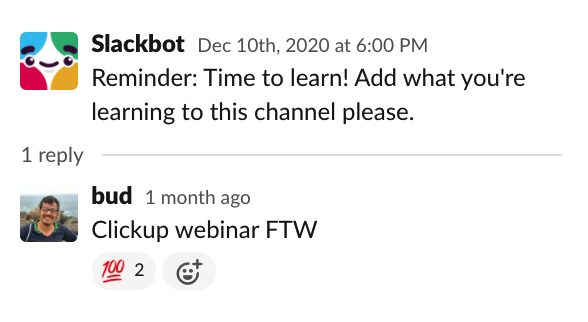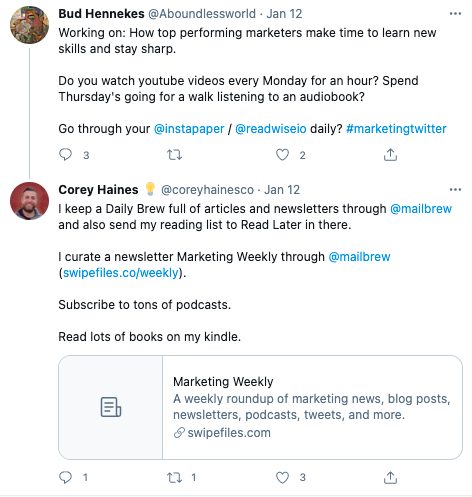The world’s best marketers don’t get to the top of their field by accident. They consume the right sources; they read the right books. They take what they learn and put it into practice.
But with the daily demands of most marketing professionals, it’s often an uphill battle to take a step back and set aside time to learn new skills. All too often, that quarterly report or urgent client request takes priority, time and time again.
Table of contents
So how do up and coming and advanced marketers prioritize professional development? How much of an impact does having dedicated learning time each week help you grow as a marketer?
We asked digital marketers via our newsletter and social media to take a brief survey to better understand the patterns and challenges faced by those climbing to the top.
Though offering just a small glimpse into marketers’ learning habits as a whole (just shy of 400 responses received), the findings were telling.
Let’s look at some of our most interesting takeaways as well as some of the most effective ways to build the habit of “sharpening the saw.”
Key Takeaways from the Learning Habits of Digital Marketers
If you want to get ahead, you have to put in the work. That’s table stakes for becoming one of the best in your field.
1. Structured Learning Yields Better Results
Nearly ⅔ of respondents reported not having a study routine. On one hand, that suggests many struggle with building the habit of structured learning or it’s simply not a priority. On the other hand, that means having one can put you ahead of your colleagues and peers.
Here are just a few of the study routines shared through our survey.
Watch a video (max 15 mins); take notes; rewatch video if I don’t understand; Google external resources (usually more videos) to get a better explanation of the things I still don’t understand. Repeat.
It depends on my objective — sometimes I study to obtain a certification to reinforce my ‘skills signals’ (narrow study) — which usually means running through e-learning modules and quizzes in a tight time frame to increase the chances of information retention to pass the final certification module.
For actual in-depth study in subjects I care about, I try to translate learning into practical application (which typically isn’t included as part of the publisher’s education experience). An example of this — using a dummy site or google tag injector to keep my google analytics knowledge and practice up to date. For deep study of a new topic, I block 30min after lunch purely for information absorption, then take a 20min nap, and then another 30min to try and put the info down, or into practice — if / when applicable.
Of those with a ‘study routine’, roughly ⅔ reported spending 16 to 60 minutes of focused learning in a single session.
Compare that to those who still spent time learning throughout the day but didn’t have a formal learning routine.
While 16.7% of those with a dedicated study routine reported learning for more than 90 minutes on average in a session, that number drops significantly for those without a routine—with just 6.8% reporting studying more than 90 minutes or more.
Additionally, those who did not report having a study routine were far more likely to study less than 15 minutes in a single session than those with a routine. More structure equals more learning.
Those who spent at least 16 to 30 minutes learning each day reported the most promotions within 12 months compared to other learning session lengths.
2. Having a Study Routine Matters More than When You Learn
There was no significant correlation between the preferred time of learning and whether or not a promotion was on the horizon from our limited data set.
Nearly ⅓ of respondents favored learning in the early morning hours, often before work.
- “30 – 60 min Monday-Friday with a hot cup of coffee before the day’s distractions begin.
- “Early in the morning after workout, I watch 30-45 min of online courses. In the evening, if I have the energy, I read.”
- “1 hour after waking up.”
- “I have no fixed study routine, but whenever I get some free time, it is easy to read or watch a course.”
Some 40% preferred learning in the evening.
- “After working hours, having dinner, and exercising, I usually sit down for an hour (or more) and study. I usually use the Pomodoro technique since it can be quite tiring studying after a long day. Having these programmed pauses help me a lot in keeping track of my studying and not lose focus.”
Others preferred the middle of the day or no particular time:
- “I usually prefer to learn something when I get an extended break, and I don’t want to waste it on Facebook.”
- “I typically allocate an hour every day to study. It doesn’t matter what hour I happen to do actual studying; I just have to do it.”
- “I don’t necessarily have a complex routine, but I try to dedicate at least 1 hour of learning daily either by taking an online course, listening to a podcast episode, reading a newsletter, or going deeper into a topic I’m interested in.”
No need to become an early bird if you prefer learning at night. Having a study routine is by far the most significant factor in increasing your chances of promotion.
How to Make Time to Sharpen the Saw
Okay, spending a few hours a week at minimum learning new skills can help you get ahead.
But how do you carve out time for learning, especially if you feel as if you don’t have any time?
Let’s take a look.
1. Plan Ahead and Block Time on Your Calendar
Don’t let the simplicity of this practice fool you. The only way you’re going to learn new skills is by investing the time to do so. One of the first things we tell new CXL members is to block off time on their calendar to go through the material.
Why? Because it works.
Just as saying you’ll go to the gym when you feel like it is seldom effective, neither is saying you’ll take that course or watch that video on SEO when you have ‘extra time.’
If advancing in your career is important to you, there’s no excuse as to why you can’t set aside at least an hour or two each week to focus solely on learning.
Don’t overcomplicate it. You don’t need to spend two hours each day studying. A few 30 minutes blocks throughout the week are more than enough to make progress.
Only 18% of those who reported learning 90 minutes or more each day reported receiving a promotion within the last 12 months. Compare that to the nearly 80% of those who spent 31-60 minutes on average studying.
After a certain point, the diminishing returns on time spent is clear.
While small might not be sexy, it is successful and sustainable. When it comes to most life changes that people want to make, big, bold moves actually don’t work as well as small, stealthy ones. Applying go big or go home to everything you do is a recipe for self-criticism and disappointment.
Tiny Habits: The Small Changes That Change Everything by BJ Fogg
Just as with setting any meaningful goal, it’s important to be specific.
“Get better at A/B testing” isn’t a clear enough goal.
Instead, get specific.
- “I’ll watch 30 minutes of videos on Google Analytics.”
- “I’ll spend an hour signing up for three of the most popular no-code tools.”
- “I’ll attend that ClickUp webinar so that I can be better organized and efficient.”
- “I’ll go through my newsletters and focus on nothing else.”
As we’ll see, more and more companies are working to make learning hours and professional development a priority both for recruiting and retaining top talent.
2. Make Professional Development a Priority, Not an Afterthought
In our survey, we also wanted to learn more about whether companies openly supported the idea of learning hours during the workday.
Unfortunately, based on our responses, there’s still quite a bit of room for improvement, with only 39.8% reporting their employers offer or support learning hours during work.

Perhaps, not surprisingly, many reported spending an hour or two before or after work learning new skills.
- “I usually study late evening or late night after my work hours.”
- “On weekends, I do two sittings. One in the afternoon and one in the night.”
- “When I am done with all the work stuff, I fire up the course I’m doing on my laptop and spend 20 min to an hour to go through a couple of lessons on my couch. I occasionally take notes or pause the video to check on my own examples. Most courses I do at 2x speed but slow down when I am unfamiliar with the topic.”
- “Becoming better at my work is one of the most valuable things I can do, and my employer agrees, so I block 2 hours in the morning to study during my workday.”
Whether you’re an employee looking to move up the ranks, or a marketing manager trying to get the most from your team, professional development shouldn’t be an afterthought.
There’s a reason why leading startups and businesses today place such a heavy emphasis on development.
I would make the argument that it costs more to hire and train someone who leaves than it costs to develop them and have them stay and be productive.
Mike Warren adjunct business professor at Brandman University.
Take a look at the hiring pages and perks of Zapier, Doist, and Buffer, for example.


Here’s Buffer talking about their unlimited Kindle and Audible books perk:
Kindle and audible books: Each teammate and one dependent may receive unlimited, no-questions-asked Kindle and Audible.com books. Reading is a cornerstone to our value of self-improvement, and this has long been a favorite benefit of working at Buffer. During a teammate’s first 45 days, US teammates will be gifted with a Kindle Paperwhite, and international teammates are invited to purchase a Kindle on their own and expense this through Expensify.
They all place a heavy focus on development, both personally and professionally.
Professional development won’t just help your employees become better at what they do; it can also help your team feel more connected and excited about their work.
Deepening existing skills, learning new skills, broadening your knowledge into another area, getting really good at what you’re passionate about… these are the primary purposes of professional development.
says Stacey Christiansen.
We even make a note of our investment in professional development here at CXL on our hiring page.
If you’re leading a marketing team, an investment in professional development must come from the top.
At CXL, each Thursday, we have what we call “study minutes,” where we set aside time for deep learning.
For example, I recently spent time watching a webinar on Clickup so I could become more efficient with my content marketing project management.

Learning hours aren’t nice to have; they are a necessity.
3. Discover How You Learn Best
Dedicating time on your calendar and making professional development a priority is a good start. But ultimately, discovering how you learn best will yield the best results long term.
You may not like watching Youtube videos on SEO. You may not be able to retain information listening to an Audible book at 2x speed. You prefer listening to podcasts rather than reading books. That’s okay.
What’s important is understanding how you operate best. As with most things in marketing and business, best practices aren’t always the best solutions for you.
Here’s how Ash Read, editorial director at Buffer, suggests stepping into professional growth as a marketer:
Try to form habits around whatever discipline of marketing you’re most excited about:
If you’re into video, download some stock footage and start editing it.
If you want to become an SEO master, try reading as much content as possible from places like Moz, Ahrefs, and Backlinko.
If writing is your thing, set aside time on your calendar each day to sit and write
It can be daunting to look at marketing and think you need to fully master: analytics, data, CRO, SEM, advertising, copywriting, SEO, community, and more.
But in reality, to be a successful marketer, you don’t need to be an expert in every channel: one or two areas of expertise will be enough.
However, before diving right in and choosing an area or two to focus on, experiment with a bunch of different skills to see what’s the best fit for you.
Here are some more study routines and methods to consider as you find what works for you.
- “I typically listen to videos at 2x speed while I read the materials. I slow parts down that are important and/or that have an action step.”
- “Clear desk, headphones, drink nearby, split screens between lesson and a google doc for notes.”
- “First preference is to learn by reading books, and second preference is to learn by using videos.”
- “Open up a separate laptop that is not work in a separate environment and work until I reach a small milestone (e.g., done three segments of a course.)”
Conclusion
Being the best at what you do is difficult and putting in the work to get there is a never-ending battle. By making learning a priority, you can rapidly advance your career and continue to hone your craft.
- Block time on your calendar for “study minutes” each week.
- If you’re a manager, build professional development into your culture.
- Discover how you learn most effectively; the sooner you know, the more your efforts can compound.
- Don’t overdo it. We found no correlation with those who spent 90+ minutes learning, receiving increased promotions compared to those who spent 30-60 minutes a day on average. In fact, those who studied less than an hour a day were more likely to receive a promotion.







